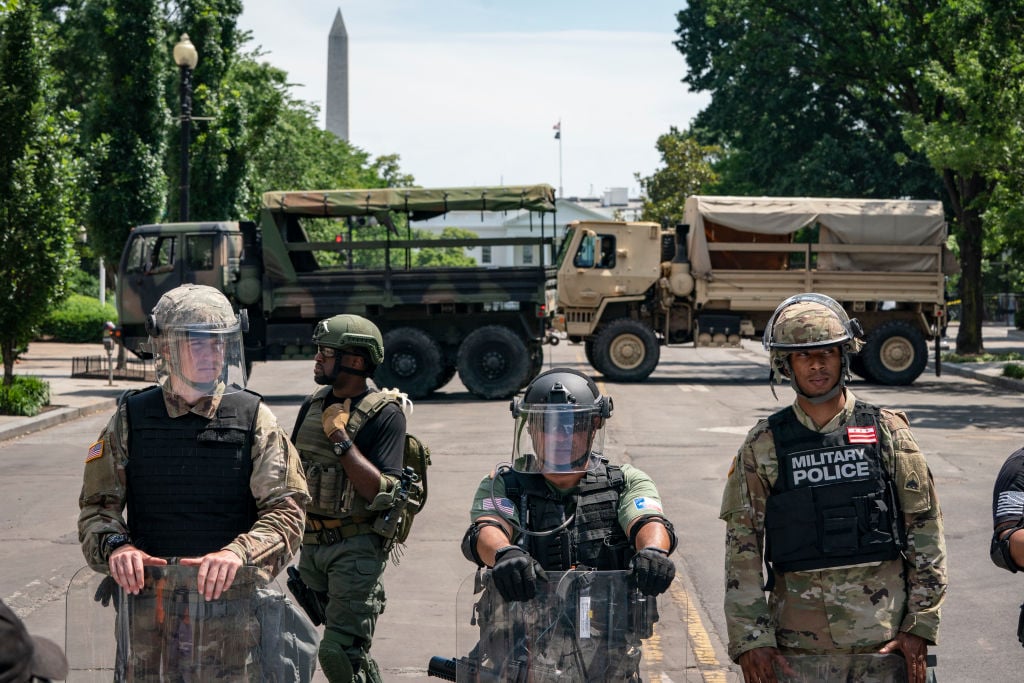President Trump is reportedly going forward with his desire to roll troops, tanks, and other military hardware down Pennsylvania Avenue, but don’t look for much support from the city that would have to host his fantasized-about military parade. The DC government, which would presumably be a stakeholder in the planning and execution of any such event, says it will not bear the cost of staging it. Moreover, city officials have heard little—if anything—from their federal counterparts.
A spokesperson for Mayor Muriel Bowser told Washingtonian on Tuesday evening that the city has not received any official request from the White House or Pentagon about planning a military parade through downtown. Bowser’s office is more adamant the following morning: “We’re tracking media reports about the proposed parade and will have more to say when formal outreach begins,” says the mayor’s communications director, Anu Rangappa. “In the meantime, we do know that just like the wall, he will have to pay for it.”
The Washington Post reported Tuesday evening that Trump, who was said to have fancied the idea of including tanks and missile launchers in January 2017 inaugural procession, became more adamant a military parade last July after attending Bastille Day festivities in Paris with French President Emmanuel Macron. Trump started pushing even harder last month, the Post reports, when he reportedly told Defense Secretary James Mattis and the Pentagon’s top uniformed officials that, “I want a parade like the one in France.”
Setting aside Trump’s apparent unawareness of the folkways behind France’s Bastille Day celebration (it commemorates a popular uprising against homegrown tyranny), the logistics required to pull off a parade featuring heavy armored vehicles and thousands of troops, the construction of a presidential reviewing stand, and the security personnel required for a scene full of high-ranking dignitaries would be close to those used to carry out a presidential inauguration. And therein lies an inevitable conflict with the District. Even when the city’s residents disagree with the results of an election, their local government is still a necessary and willing participant in planning the winner’s swearing-in.
But city officials aren’t so eager to help out in staging an event that doesn’t seem to be pegged to anything more than satisfying the President’s military fetish. And they have reasons to be hesitant. Big parades are costly affairs. The District spent $20 million on the 2017 inauguration, and while the federal government later reimbursed that sum, the money still had to be set aside in the first place. Ultimately, DC may have little say in the matter, as the stretch of Pennsylvania Avenue between the Capitol and the White House is a national historic site that’s controlled as much by the federal government as it is by the city. But inaugural expenses are associated with an event that happens on a regular schedule. There’s no line item in the city’s budget for planning an off-year parade, or any guarantee that the federal government would pay back the local governments that’d be dragooned into working the military parade.
And if history is any guide, the costs could quickly pile up. The last big military parade, in June 1991, featured 8,000 troops and lineups of Bradley Fighting Vehicles and 72-ton M1 Abrams tanks crawling along 200,000 spectators on Constitution Avenue. While organizers originally estimated the day would cost $8 million, with $5 million coming from private donors, the final tab climbed to $12 million, with taxpayers footing the balance.
Moreover, though, the District’s reluctance to help plan a military parade may simply be a matter of taste. Expensive as it was, the 1991 parade was staged to mark the end of the Gulf War. The one last one before that, in 1946, celebrated the Allied victory in World War II. The present-day United States is not marking the conclusion of any foreign wars.
White House Press Secretary Sarah Sanders says Trump wants the parade as way for people to “show their appreciation” for members of the US armed forces. Military appreciation isn’t exactly lacking though, between Memorial Day, Veterans Day, memorials, monuments, names of roadways, State of the Union addresses, benefit concerts, NFL games, and Michael Bay movies. But putting hardware on display at random isn’t a US tradition. Even President George W. Bush‘s “Mission Accomplished” stunt was crafted to celebrate, quite inaccurately, the end of “major combat operations” in Iraq. A military parade in 2018 might be seen as naked fetishism designed to satisfy the emotional needs of a President who is overwhelmingly despised by the city in which he resides.
Which makes DC officials’ immediate pushback on the notion understandable. “Military parade down the streets of DC to feed an insecure man’s fragile ego? That’d be a big no,” DC Council member Charles Allen wrote on Twitter Tuesday night. In a direct message with Washingtonian, Allen says he may try to introduce legislation aimed at blocking a parade.


















